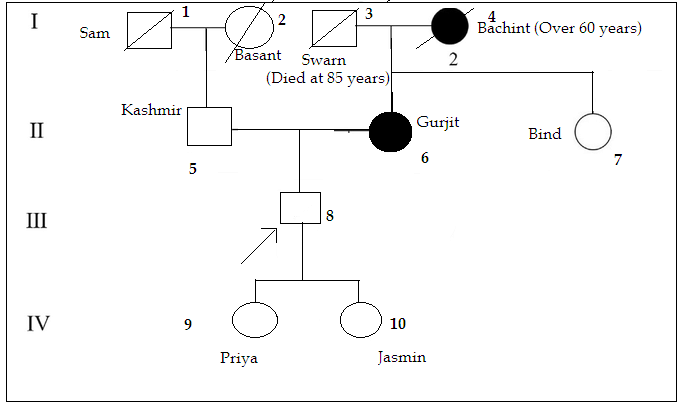Hereditary diseases form a major health challenge that professionals in the medical sector, geneticists, and researchers should take seriously. Different tools have emerged that can guide all involved stakeholders to make informed decisions and support the changing needs of the targeted patients. Hypertension is a common condition that has been observed to run in many families. This disease results in additional complications, such as stroke and heart disease. Increased pressure is a health challenge that calls for immediate medical support. This detailed analysis presents me as the proband for the pedigree with hypertension.
Family Pedigree

The connection between genes and hypertension is an area that has attracted attention of many researchers and experts. This condition is a risk factor for different diseases that can eventually result in death (Patel et al., 2017). Family history was the main source of the information presented above. Family members and relatives who developed this condition have been filled accordingly (see Figure 1). Normal persons without any medical condition have been depicted using clear squares for males and circles for females. The square with the indicated arrow is the proband (III8).
Identifiable Hereditary Patterns
From the above chart, it is evident that hypertension is a hereditary pattern that exists in this family. My late maternal grandmother Bachint was diagnosed with hypertension during her old, and she died at the age of over 60 years. My mother Gurjit has been diagnosed with the same condition. She has been undertaking evidence-based measures to manage this disease. Such a practice is essential since hypertension is associated with numerous health challenges.
Risk of Transmission
The presented diagram reveals that this disease might be running in my family. The fact that my mother and my grandmother developed it is a clear indication I am at risk of developing it in the future. There is a possibility that it has some genetic connection. Similarly, I agree that my daughters might have increased chances of developing hypertension. This knowledge means that all my relatives and children should be aware of this condition in order to protect themselves against the diseases associated with it, such as stroke and diabetes (Luft, 2017). This form of understanding can empower them to stay safe and be willing to seek the necessary medical support. This practice will make it easier for them to record positive health outcomes.
Feasibility of Use
Family pedigrees are powerful tools that scholars and medical professionals can use to monitor the nature or trend of specific diseases in a given family. They guide health experts to make timely connections and identify some of the possible causes of certain diseases (Patel et al., 2017). The tool is also useful when patients provide timely and reliable information to their physicians and practitioners. The acquired data will eventually inform the entire care delivery process.
As a professional in this field, I will be on the frontline to apply a similar model to meet the needs of my patients. The ideas and skills gained from this class are essential and can guide me to make informed decisions whenever dealing with patients who have specific conditions that are prevalent in their respective families. I will share the collected information with other professionals and practitioners and find evidence-based approaches to meet the health demands of the targeted individuals (Jarvik & Browning, 2016). The framework will also guide me to identify how other patients in the targeted family might have responded to various treatment regimes. This information can become a new source of knowledge to empower more patients and make it easier for them to record positive health outcomes.
Another possible way of utilizing a family pedigree is identifying families that might be at risk of various hereditary conditions. Any patient who has been diagnosed with a genetic disease will be targeted to identify his or her relatives and encourage them to consider new ways of getting medical guidance. This strategy is essential since the individuals might be at risk of developing the specific genetic condition and even experience various medical predicaments (Patel et al., 2017). This kind of information will encourage them to consider the right resource and implement precautionary measures that will eventually protect them against the identified genetic condition (Luft, 2017). Consequently, this will become an evidence-based practice for providing care and health advice to my future patients and their respective family members.
Conclusion
The above discussion has identified the use of a family pedigree as a powerful model for learning more about various hereditary conditions. My wider family appears to be at risk of hypertension. These insights can become meaningful ideas for protecting all members against this condition. I will go further to complete similar tools in my future practice in order to understand my patients’ health demands and offer timely advice to their relatives. Such a model can eventually meet the health demands of the greatest number of citizens in this country.
Reference List
Jarvik, G. P., & Browning, B. L. (2016). Consideration of cosegregation in the pathogenicity classification of genomic variants. The American Journal of Human Genetics, 98(6), 1077-1081. Web.
Luft, F. C. (2017). What have we learned from the genetics of hypertension? Medical Clinics, 101(1), 195-206. Web.
Patel, R. S., Masi, S., & Taddei, S. (2017). Understanding the role of genetics in hypertension. European Heart Journal, 38(29), 2309-2312. Web.